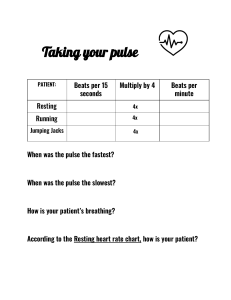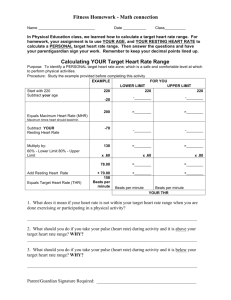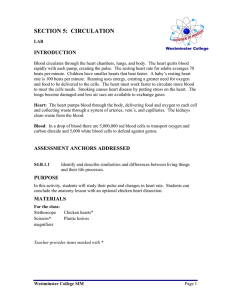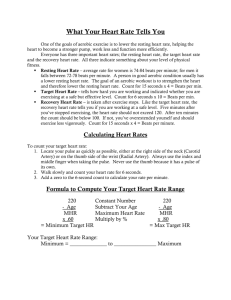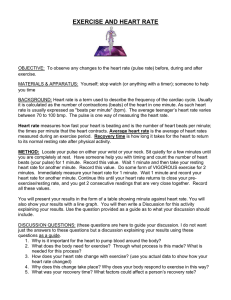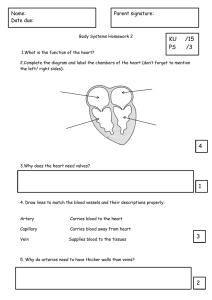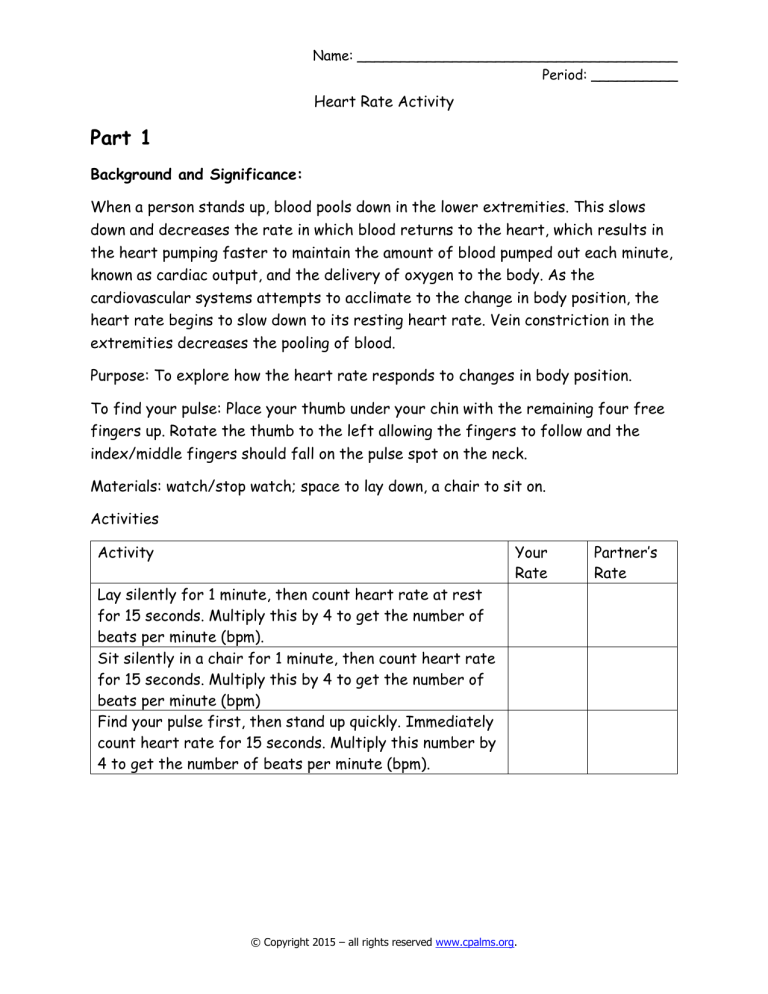
Name: _____________________________________ Period: __________ Heart Rate Activity Part 1 Background and Significance: When a person stands up, blood pools down in the lower extremities. This slows down and decreases the rate in which blood returns to the heart, which results in the heart pumping faster to maintain the amount of blood pumped out each minute, known as cardiac output, and the delivery of oxygen to the body. As the cardiovascular systems attempts to acclimate to the change in body position, the heart rate begins to slow down to its resting heart rate. Vein constriction in the extremities decreases the pooling of blood. Purpose: To explore how the heart rate responds to changes in body position. To find your pulse: Place your thumb under your chin with the remaining four free fingers up. Rotate the thumb to the left allowing the fingers to follow and the index/middle fingers should fall on the pulse spot on the neck. Materials: watch/stop watch; space to lay down, a chair to sit on. Activities Activity Your Rate Lay silently for 1 minute, then count heart rate at rest for 15 seconds. Multiply this by 4 to get the number of beats per minute (bpm). Sit silently in a chair for 1 minute, then count heart rate for 15 seconds. Multiply this by 4 to get the number of beats per minute (bpm) Find your pulse first, then stand up quickly. Immediately count heart rate for 15 seconds. Multiply this number by 4 to get the number of beats per minute (bpm). © Copyright 2015 – all rights reserved www.cpalms.org. Partner’s Rate Name: _____________________________________ Period: __________ Questions/Discussion 1. Is the effect greater for tall or short individuals? Why do you think this is so? 2. Why can people faint when standing at attention without moving? How does exercise help? 3. Why are astronauts put in a horizontal position during take-off? 4. Would the same effect (of moving to an upright position) occur during a space flight? Part 2 Background How physically fit a person is can be determined by tests that are designed to measure heart rate during exercises, the amount (volume) of oxygen consumed during exercise (VO2 max), muscles flexibility and fitness, body fat percentages and heart rate recovery. Heart rate recovery is the time it takes for the heart to return to its normal resting beat. The quicker the heart rate returns to a normal resting beat, the healthier it is. The recovery rate can be improved by making better choices and lifestyle changes in diet, exercise and not smoking. Normal resting heart rate values for different ages are: newborn infants: 100 to 160 beats per minute children 1 to 10 years: 70 to 120 beats per minute children over 10 and adults (including seniors): 60 to 100 beats per minute Athletes can have much lower resting heart rates, as low as 40 to 60 beats per minute. © Copyright 2015 – all rights reserved www.cpalms.org. Name: _____________________________________ Period: __________ Now that you understand how body positions affect the heart rate, we will explore how physical activity affects the heart rate. In this activity, you will take your own pulses after exercise and at rest to determine recovery times. You may use the same resting heart rate as the previous activity (heart rate laying down) and document your heart rate doing the physical activities using the same methods. **Remember** LISTEN TO YOUR BODY. Complete the activities to the best of your abilities. Physical Activity Your Rate Resting Heart Rate Standing relaxed After walking around the classroom for 2 minutes After jogging in place for 2 minutes After doing 25 jumping jacks After 1 minute -------- After 2 minutes --------- Complete the labeling of the graph and fill in with your results. Use different colors to distinguish the immediate heart rate from the 1 minute heart rate and the 2 minute heat rate. © Copyright 2015 – all rights reserved www.cpalms.org. Name: _____________________________________ Period: __________ Questions/Discussion 1. What activity were you doing when your heart was beating the fastest? 2. During recovery/down time (the minute between activities), what happened to your heart rate? 3. Could you tell when your heart rate was increasing or decreasing? How did you feel? 4. What is happening with the blood flow (rate/opening and closing of valves) as your heart rate increases? Decreases? 5. How does being physically fit affect your heart rate? © Copyright 2015 – all rights reserved www.cpalms.org. Name: _____________________________________ Period: __________ In the chart below, label with arrows the direction of blood flow and COLOR the where the oxygen rich blood (red) and oxygen poor blood (blue) would be located at any given time. Also label the valves. commons.wikimedia.org (CC BY-SA 3.0) © Copyright 2015 – all rights reserved www.cpalms.org.
